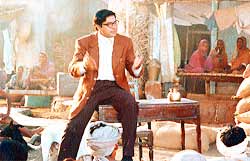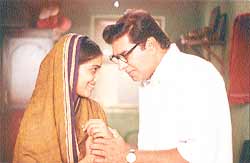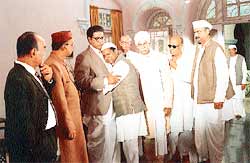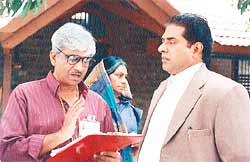|

Better late than never!
So it’s finally hitting the screens next week. Jabbar
Patel’s much-awaited movie, Dr Babasaheb Ambedkar, for
which Mammootty bagged the best actor award, last year, is
being released at long last...
“THE
film’s making, right from conception to creation has,
for me, been an experience in itself. Recreating the life
of one of the greatest visionaries in Indian history has been
an experience of a lifetime,” says Jabbar Patel.
AMBEDKARSPEAK
**** “A Swaraj, where there are no fundamental rights
guaranteed for the depressed classes, will not be a Swaraj
for us. It will be a new slavery.”
**** “The decision to launch the Quit India Movement
in the wake of an emergency like the world war is irresponsible
and unintelligent.
*** “Don’t call Gandhi a saint. He is a seasoned
politician. When everything else fails, Gandhi will resort
to intrigue.”
**** “Don’t fall under Gandhi’s spell,
he’s not God... Mahatmas have come and Mahatmas have
gone but untouchables have remained untouchables.”
**** “Our salvation lies in political power, not
pilgrimages and fasts. Do not use the weapon of fast so
often. Your life is precious and the country needs you.” |
The film evolved from the documentary film he made on the
life of Dr Ambedkar for Films Division in 1989. Shooting for
this documentary was also done part in the US and the UK and
mainly in India when Patel met people who were in actual contact
with Dr Ambedkar. “The incidents related to me by these
people, their fond memories of the learned visionary were
so touching and exciting that I thought, the only true tribute
to the great man would be a lifesize sketch of Dr Ambedkar
on the silver screen.”
The recreation of the period in India and abroad as well,
was a huge task. Institutes like the Columbia University New
York and the London School of Economics where Dr Ambedkar
studied, lent support and the shoots were done free of cost.
The ordeal of recreation did not limit itself to just the
architecture or the period but it went as far as the actor
who had to live the role of Ambedkar. The search for the actor
did not limit itself to India but was also carried out on
the other side of the Atlantic. But finally it was the face
and the talent of the Southern superstar, Mammootty that presented
itself.
The choice of Mammootty to play the role of Ambedkar was so
appropriate that hundreds of untouchables or Dalits who would
come to take part in shootings would be so emotionally moved
that they would come to Mammootty with devotion in their hearts
and tears in their eyes.
The technicians working for the film had an ambition. They
wanted to achieve technical excellence, a film that was made
on international standards and that would stand the test of
an international audience. And so the style of production
was lavish.
A select few have already seen the film in special screenings
and have appreciated it to a great extent. These include people
from the field of art, literature, law and politics. And their
reactions have been favourable. Some representing the common
stratum of society have also previewed the film and their
reactions have been touching and overwhelming, especially
those who were contemporaries of Dr Ambedkar.
The film is significant in that, though the ethos is Indian,
it has an universal appeal. After all, political and social
disparity is a feature of civilisations all over the world.
The basic aim of the social revolution is to uphold the meaning
of humanity in its true sense.
The film spans between the years 1901-1956, and takes us through
60 years, two world wars, and three countries — India,
USA and Britain. Both a personal portrait, as well as a record
of the times, it is above all one man’s fight against
the tyranny of Hindu orthodoxy, against tradition, against
Indian political heroes and saints such as Mahatma Gandhi,
who were more interested in political reforms than social
reforms. Dr Ambedkar walked a lonely path: he never once strayed
from it, even though in the process he became the most hated
man in Hindu India.
Born in an ‘untouchable’ family at a time when untouchables
were forbidden education, Ambedkar bore many insults and humiliations
at the hands of his fellow students and became the first graduate
of his community. Later, while studying at Columbia University,
New York, Ambedkar was able to rid himself of the stigma of
untouchability and breathe the air of freedom. But at the
same time living next to Harlem he could equate the fate of
his people with that of the Afro-Americans.
Though they belonged to the same religion, untouchables were
treated worse than the lowliest animals by the upper castes.
Sanctified by religion and centuries of tradition, high caste
Hindus considered themselves polluted if they came into contact
with an untouchable. Though they worshiped the same God they
could not enter the temples. All public services including
the police and the military were closed to them. They were
permitted only to follow their hereditary occupations of scavenging,
street sweeping, skinning and tanning animal hides.
Gandhi appealed to Hindus for a change of heart. On the other
hand Ambedkar wanted political rights. Gandhi saw untouchables
as an indivisible part of Hindu society. Ambedkar, disgusted
with Hinduism saw the depressed classes as separate. Gandhi
thought once the British left, India would right itself.
Ambedkar was not willing to take the chance. “Don’t
call Gandhi a saint. He is a seasoned politician. When everything
else fails, Gandhi will resort to intrigue. Don’t fall
under his spell, he’s not God... Mahatmas have come and
Mahatmas have gone but untouchables have remained untouchables,”
Ambedkar warned his people.

This confrontation with Gandhi, which made Ambedkar the most
hated man in India, was resolved with Indian Independence
when Gandhi insisted Ambedkar to be inducted into the first
cabinet. Even though they had been on opposite side of the
fence, Gandhi respected his former adversary. Thus Ambedkar
became India’s first law minister under Prime Minister
Nehru and it fell upon him to draft India’s Constitution.
Throughout his life Ambedkar’s endeavours to reform Hindu
society had borne stubborn resistance and he had been on a
life long search for a religion, a moral social order that
would not sanctify the exploitation of man by man. His search
led him to Buddhism, which he regarded as rational and egalitarian.
On 14th October 1956 Ambedkar renounced Hinduism and embraced
Buddhism. Millions of untouchables followed him, threw away
their Hindu idols, embraced en masses this new religion. This
perhaps was the biggest social revolution witnessed by the
subcontinent in a millennia.
Though this story is particular to India, it is also universal.
While Dr Ambedkar was rooted in India, he also had an international
outlook. There will always be people like him who struggle
to better the lot of the exploited, the downtrodden, and the
forgotten. His was the universal fight of the underdog, to
gain his people a rightful place in the sun.
|




